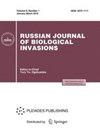FORMATION OF THE RANGES OF INVASIVE PLANT SPECIES IN THE REPUBLIC OF ALTAI: RESULTS OF THE CENTENNIAL NATURALIZATION
IF 0.6
Q4 ECOLOGY
引用次数: 0
Abstract
Currently, 10-15% of invasive plant species are recorded in alien floras of all inhabited regions of the world, and their proportion is constantly growing. A particular problem is naturalization of alien species in the regions with high levels of endemism and species diversity, such as the Republic of Altai. We have been studying the alien flora of the Republic of Altai since the beginning of the 21st century. The ranges of 67 invasive species belonging to 57 genera and 20 families have been identified. Most of the species have been known on the territory of the Republic of Altai since the 20th century, 10 species have penetrated here in the 21st century. The main method of penetration (vector) is accidental introduction. In all areas, at least singly, there are 5 species: Amaranthus retroflexus, Bunias orientalis, Matricaria discoidea, Melilotus officinalis, Tripleurospermum inodorum . The orographic and climatic features of the area predetermine a greater susceptibility to invasions for the northern regions and a lesser one for the southeastern regions. Eighteen species are distributed only in the northern regions. Almost all species are found in Gorno-Altaisk and Mayma district, the least number of species - in Kosh-Agach district, which is characterized by the most severe climatic conditions. Thirty five species are invasive in Siberia, 11 species are among the hundred most aggressive species in Russia. Based on our own long-term research, taking into account the analysis of available publications and stock materials (Herbarium of the Central Siberian Botanical Garden of the Siberian Branch of the Russian Academy of Sciences and Gorno-Altai State University), as well as other available data (iNaturalist, GBIF), maps of the ranges of invasive plants of the Republic of Altai were compiled. For each species, all known localities are given, indicating administrative regions, settlements, river valleys, etc., the time of discovery is noted, and links to the source are indicated.阿尔泰共和国入侵植物物种范围的形成:百年归化的结果
目前,在世界所有有人居住地区的外来植物区系中,有10-15%的外来入侵植物物种被记录在案,而且这一比例还在不断增长。一个特别的问题是外来物种在地方性和物种多样性程度很高的区域,如阿尔泰共和国的归化。自21世纪初以来,我们一直在研究阿尔泰共和国的外来植物群。已查明入侵物种67种,隶属于20科57属。大多数物种自20世纪以来在阿尔泰共和国境内被发现,21世纪有10种物种渗透到这里。穿透(矢量)的主要方法是偶然引入。在所有地区,至少在单个地区,有5种:逆行苋、东方布纳斯、盘状麻、木犀草、三胸草。该地区的地形和气候特征预先决定了北部地区对入侵的易感性较大,东南部地区的易感性较小。18种只分布在北部地区。几乎所有的物种都在Gorno-Altaisk和Mayma地区发现,物种数量最少的是Kosh-Agach地区,其特征是气候条件最恶劣。在西伯利亚有35种是入侵物种,在俄罗斯100种最具侵略性的物种中有11种。基于我们自己的长期研究,考虑到现有出版物和库存材料的分析(俄罗斯科学院西伯利亚分院西伯利亚中央植物园植物标本馆和戈尔诺-阿尔泰国立大学),以及其他可用数据(iNaturalist, GBIF),编制了阿尔泰共和国入侵植物范围的地图。对于每个物种,都给出了所有已知的地点,指出了行政区域,定居点,河谷等,注意到发现的时间,并指出了与来源的链接。
本文章由计算机程序翻译,如有差异,请以英文原文为准。
求助全文
约1分钟内获得全文
求助全文
来源期刊
CiteScore
1.20
自引率
14.30%
发文量
40
期刊介绍:
Russian Journal of Biological Invasions publishes original scientific papers dealing with biological invasions of alien species in both terrestrial and aquatic ecosystems and covers the following subjects:description of invasion process (theory, modeling, results of observations and experiments): invasion corridors, invasion vectors, invader species adaptations, vulnerability of aboriginal ecosystems;monitoring of invasion process (reports about findings of organisms out of the limits of natural range, propagule pressure assessment, settling dynamics, rates of naturalization);invasion risk assessment; genetic, evolutional, and ecological consequences of biological invasions of alien species; methods, means of hoarding, processing and presentation of applied research data (new developments, modeling, research results, databases) with factual and geoinformation system applications;use of the results of biological invasion research (methods and new basic results) under the study of marine, fresh-water and terrestrial species, populations, communities and ecosystems; control, rational use and eradication of the harmful alien species..

 求助内容:
求助内容: 应助结果提醒方式:
应助结果提醒方式:


